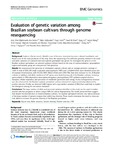Please use this identifier to cite or link to this item:
http://www.alice.cnptia.embrapa.br/alice/handle/doc/1037089| Title: | Evaluation of genetic variation among Brazilian soybean cultivars through genome resequencing. |
| Authors: | SANTOS, J. V. M. dos  VALLIYODAN, B.   JOSHI, T.   KHAN, S. M.   LIU, YANG.   WANG, J.   VUONG, T. D.   OLIVEIRA, M. F. de   MARCELINO-GUIMARÃES, F. C.   XU, D.   NGUYEN, H. T.   ABDELNOOR, R. V.   |
| Affiliation: | JOÃO VITOR MALDONADO DOS SANTOS, UEL; BABU VALLIYODAN, UNIVERSITY OF MISSOURI; TRUPTI JOSHI, UNIVERSITY OF MISSOURI; SAAD M. KHAN, UNIVERSITY OF MISSOURI; LIU, Y., UNIVERSITY OF MISSOURI; JUEXIN WANG, UNIVERSITY OF MISSOURI; TRI D. VUONG, UNIVERSITY OF MISSOURI; MARCELO FERNANDES DE OLIVEIRA, CNPSO; FRANCISMAR CORREA MARCELINO GUIMARA, CNPSO; DONG XU., UNIVERSITY OF MISSOURI; HENRY T. NGUYEN., UNIVERSITY OF MISSOURI; RICARDO VILELA ABDELNOOR, CNPSO. |
| Date Issued: | 2016 |
| Citation: | BMC Genomics, v. 17, n. 110, 18 p., Feb. 2016. |
| Description: | Soybean [Glycine max (L.) Merrill] is one of the most important legumes cultivated worldwide, and Brazil is one of the main producers of this crop. Since the sequencing of its reference genome, interest in structural and allelic variations of cultivated and wild soybean germplasm has grown. To investigate the genetics of the Brazilian soybean germplasm, we selected soybean cultivars based on the year of commercialization, geographical region and maturity group and resequenced their genomes. We resequenced the genomes of 28 Brazilian soybean cultivars with an average genome coverage of 14.8X. A total of 5,835,185 single nucleotide polymorphisms (SNPs) and 1,329,844 InDels were identified across the 20 soybean chromosomes, with 541,762 SNPs, 98,922 InDels and 1,093 CNVs that were exclusive to the 28 Brazilian cultivars. In addition, 668 allelic variations of 327 genes were shared among all of the Brazilian cultivars, including genes related to DNA-dependent transcription-elongation, photosynthesis, ATP synthesis-coupled electron transport, cellular respiration, and precursors of metabolite generation and energy. A very homogeneous structure was also observed for the Brazilian soybean germplasm, and we observed 41 regions putatively influenced by positive selection. Finally, we detected 3,880 regions with copy-number variations (CNVs) that could help to explain the divergence among the accessions evaluated. The large number of allelic and structural variations identified in this study can be used in marker-assisted selection programs to detect unique SNPs for cultivar fingerprinting. The results presented here suggest that despite the diversification of modern Brazilian cultivars, the soybean germplasm remains very narrow because of the large number of genome regions that exhibit low diversity. These results emphasize the need to introduce new alleles to increase the genetic diversity of the Brazilian germplasm. |
| Thesagro: | Soja Variedade Genoma Variação genética |
| NAL Thesaurus: | Soybeans Cultivars High-throughput nucleotide sequencing Genetic variation |
| ISSN: | 1471-2164 |
| DOI: | 10.1186/s12864-016-2431-x |
| Type of Material: | Artigo de periódico |
| Access: | openAccess |
| Appears in Collections: | Artigo em periódico indexado (CNPSO)  |
Files in This Item:
| File | Description | Size | Format | |
|---|---|---|---|---|
| EvaluationofgeneticvariationamongBraziliansoybeancultivarsthroughgenomeresequencing.pdf | 2.28 MB | Adobe PDF |  View/Open |









